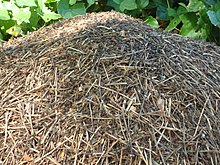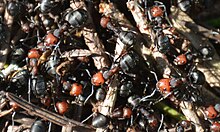Formica obscuripes
| Formica obscuripes | |
|---|---|

| |
| F. obscuripesworker | |
| Scientific classification | |
| Domain: | Eukaryota |
| Kingdom: | Animalia |
| Phylum: | Arthropoda |
| Class: | Insecta |
| Order: | Hymenoptera |
| Family: | Formicidae |
| Subfamily: | Formicinae |
| Genus: | Formica |
| Species: | F. obscuripes
|
| Binomial name | |
| Formica obscuripes Forel,1886
| |
Formica obscuripes,thewestern thatching ant,is a species ofantin the familyFormicidae.It is native toNorth America.It produces large mounds covered by small pieces of plant material.[1]The number of adult workers per colony may be as high as 40,000.[2]F. obscuripesfeeds upon a number of insect species, consumes nectar fromhomopterousinsects they tend, and occasionally eats plant tissue.[1]
Biology
[edit]Colonies
[edit]


F. obscuripescreates distinct, dome-shaped mounds composed of varying materials found in the nest's surrounding environment. This composition is primarily vegetation and is commonly called "thatch". The mounds are typically constructed in areas devoid of cover to expose the nest to sunlight. The size of these mounds is highly variable and is mostly determined by the age and health of the colony. The height ranges from 1 to 18 inches (15–45 cm), although nests of larger heights are not uncommon, and can extend down to 4 ft (1.2 m) in the ground, with chambers present in both the thatched mound and the soil. The condition of the thatched mound is in a constant state of change due to activities by the ants and changes in the environment.[3] To prevent plants from shading the nest, the ants may chew off the bark at the base of plants growing on or nearby the mound.Formic acidis then sprayed into the open layer eventually killing and felling the plants.[4]
In the Blue Mountains of Oregon,F. obscuripeshas demonstrated the capacity forpolydomy.Asupercolonyin a four-hectare (9.9 acre) study area nearLehman Hot Springsconsisted of 210 active nests with an estimated population in excess of 56 million ants.[5]
Chemistry
[edit]The poison sprayed byFormica obscuripesconsists of formic acid, eight straight-chain alkanes, a branched-chain alkane and five alkenes. The major component, formic acid, has been found to vary from 8 to 96% and average 73% of the volatiles in the secretion. A variation was also seen with the second most abundant compound, undecane, which ranged from 3 to 63% of the sprayed secretion and averaged 19%.[6]
Distribution
[edit]F. obscuripesis found in a variety of habitats in North America, particularly theUnited States of America.Most specimens are collected from theMidwestand between theRocky Mountainsand the American west coast.[7]Populations in thePacific Northwestmay represent a distinct species,Formica planipilis,[8]and have been described by hobbyists as typically producing larger colonies and mounds than populations elsewhere, though this has not been confirmed. Pacific Northwest populations are additionally distinguished by the unique coloration of thegynes,which sport entirely black bodies with red heads.
References
[edit]- ^abHeikkinen, M. W. (1999)."Negative effects of the western thatching ant (Formica obscuripes) on spiders (Araneae) inhabiting big sagebrush (Artemisia tridentata) ".Great Basin Naturalist.59(4): 380–383.
- ^Capinera, J. L. (2008).Encyclopedia of Entomology, Volume 3.Springer. p. 4215.ISBN978-1-4020-6242-1.
- ^Weber, N (1935)."The Biology of the Thatching Ant,Formica rufa obscuripesForel, in North Dakota "(PDF).Ecological Monographs.5(2): 165–206.Bibcode:1935EcoM....5..165W.doi:10.2307/1948522.JSTOR1948522.
- ^Cole, S.C. Jr. (1932)."The Thatching Ant,Formica obscuripesForel "(PDF).Psyche: A Journal of Entomology.39(1–2): 30–33.doi:10.1155/1932/61715.
- ^J. McIver, T. Torgersen and N. Cimon.A supercolony of the thatch antFormica obscuripesForel (Hymenoptera:Formicidae) from the Blue Mountains of Oregon.Northwest Science vol 71 issue 1, Feb 1997 (full-text)
- ^Faith G. W.; Sollers B. G.; D Feeny R. M.; Wood W. J. L.; Wood W. F. (2011). "Chemical analysis of the defensive secretion from the western thatching ant,Formica obscuripes".Journal of Undergraduate Chemistry Research.10:15–17.
- ^"Species: Formica obscuripes".AntWeb. Version 8.108.California Academy of Science. 2024.Retrieved18 August2024.
- ^Stockan, Jenni A.; Robinson, Elva J. H.; Trager, James C.; Yao, Izumi; Seifert, Bernhard (June 2016).Wood Ant Ecology and Conservation.Cambridge University Press.doi:10.1017/CBO9781107261402.ISBN9781107261402.
External links
[edit] Media related toFormica obscuripesat Wikimedia Commons
Media related toFormica obscuripesat Wikimedia Commons- "Formica obscuripes"at theEncyclopedia of Life
- "Discover Life:Formica obscuripes".Retrieved2010-09-19.
- "BugGuide: Western Thatching Ant - mound -Formica obscuripes".Retrieved2010-09-19.
- "BugGuide: Western Thatching Ants -Formica obscuripes".Retrieved2010-09-19.
- "AntWiki: Formica obscuripes".Archived fromthe originalon 2014-07-29.Retrieved2015-04-19.
